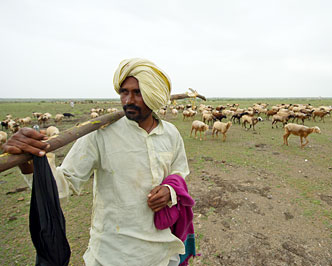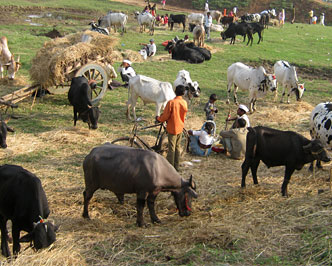News & Updates
-
- May 30, 2020
Dirty Pigs, Epidemics and a Contagion that Flows Down the River .
Dirty Pigs, Epidemics and a Contagion that Flows Down the River .
A version of this article appears in https://science.thewire.in/health/african-swine-fever-pig-farming-industrial-piggeries-assam-arunachal-pradesh/
Nitya S. Ghotge, Sumi Krishna, Mamta Dhawan and Chandana C. Baruah
The year 2020 will go down as the “Year of Disasters” – a global pandemic, the collapse of health care systems, the plight of India’s migrant labourers, failing economies, bankrupt businesses. It doesn’t end here, eastern India and Bangladesh have been battered by a super-cyclone after two decades, even as locust swarms presumably from Pakistan are spreading throughout Rajasthan and across into Madhya Pradesh and other States, reportedly the first such swarm since 1992-93. And, silently, an unprecedented epidemic disease affecting pigs is flowing rapidly down the Brahmaputra and its tributaries to the flood-prone areas of Assam.
Since February this year, African Swine Fever has killed over 17,000 pigs in Assam and unknown numbers in Arunachal Pradesh. According to the World Organisation for Animal Health (known by its abbreviation OIE), African Swine Fever (ASF) is a severe viral disease affecting wild and domestic pigs. It is an extremely contagious “transboundary” disease that swiftly crosses national borders, spread by live or dead, wild or domestic pigs, and even by fresh or packaged pork products. Transmission can also happen through shoes, clothes, knives, and equipment.
There is no medicine for, or vaccine against, ASF and can rapidly decimate pig populations in an area, although it does not infect humans. This is the first time India has reported the disease, which is more lethal than the Classical Swine Fever that has often killed a large number of pigs and for which there is a vaccine. Classical Swine Fever is zoonotic though, that is it can transmit to humans. Since it has never made an appearance in the country before, it was sometime before it was accurately diagnosed. Now, the livestock sector in Assam is in disarray as several farmers have lost their livelihoods, and there is no real relief in the recently announced government “package”.
In 2016, Anthra had undertaken an informal survey of pig-rearing systems in the country. India has had a culture of back yard pig-rearing mainly in Goa, Kerala and the North Eastern States where products made from pig are relished and processed into different delicacies. Pigs are also reared under scavenging, semi-scavenging and back yard systems in Jharkhand, Chhattisgarh and in most other States. For many, it is an important source of food. Pig fat is also used as medicine.
When we interviewed the women and men pig-farmers, especially those rearing backyard pigs, we learnt that many were reducing their holdings and even closing their units. The common refrain was: “It is unhygienic”. Indeed, in one Meghalaya village Mawlynnong reputed to be Asia’s cleanest village, free-range pigs are not permitted for this reason. Instead, outside Shillong the state capital stood a shiny new modern abattoir and meat-processing unit bearing testimony to the aspiration to change to modern systems.
Over the years, the Government animal husbandry extension systems had managed to convince pig farmers from Goa to Meghalaya that their way of rearing pigs was unhygienic and that it was better to have modern piggeries or pig farms. It was probably the same refrain which was repeated often enough in China where more than 50% of the back yard pig farms have been replaced with industrial farms which hold thousands of pigs in one unit. Such industrial piggeries housing many animals together in very close quarters easily become the epicenters of epidemics.
Since 2018, China and several East Asian countries have been struggling with an ASF epidemic of gigantic proportions. China culled over a million pigs – almost a quarter of the world’s pork supply. South Korea (which was also affected) deployed snipers and drones to kill infected pigs that were crossing over from North Korea. Vietnam has had to kill up to 6 million pigs. Unfortunately, the people who were worst affected were the small farmers who did not have the wherewithal to face an epidemic. In Europe too, the disease is said to be crossing borders as several populations of wild boar are affected.
Many countries are working on a vaccine for ASF. Vaccine development has been hindered by large gaps in knowledge about ASF infection, immunity and natural variation among strains. In March 2020, however, the Harbin Veterinary Research Institute, China, claims to have successfully conducted trials of an ASF vaccine that “provides complete protection” to pigs, commercial pigs and pregnant sows. The trial results are encouraging but it will take a long time for a commercial vaccine to be available. And even then an imported vaccine may still be out of reach for the smallholder farmer.
In the meanwhile, thousands of pigs will die in India and globally. The disease may spread to populations of wild boar in our forests and wildlife sanctuaries. More farmers will lose their livelihoods as smallholders may have no option but to cull diseased pigs.
There is nothing hygienic or heroic about culling farm animals. It is tragic and leaves those who must perform this task distraught – as we know from the experience of veterinarians after the 2001 epidemic of Foot and Mouth Disease in Europe and UK (a viral illness that affects cloven-hoofed animals), and from the experience of farmers, extension workers and veterinarians after the 2006 pandemic of bird flu in India when millions of birds had to be culled and buried. Unfortunately, extension staff and veterinarians seldom write or talk about such issues.
The other disastrous outcome of the industrial system is that farmers lose control of farming to corporate entities that are unconnected with the land and whose main motive is profit. This is true of the industries which produce mono-cultured or genetically-engineered animals, as also feed and food-processing industries, and pharmaceutical, vaccine and antibiotic industries. By juggling costs and profits, their supply chains reach across countries and continents effectively displacing small farmers.
We do not really know enough about the extent of damage industrial farming systems cause to the environment and social wellbeing. For instance, hormones are used in large quantities for optimal growth and antibiotics to control infections, which end up in the soil and in our food. Antibiotic resistance is now a major problem, world-wide. (Soon consumers too may be confused wondering whether the perfect-looking egg or cut of meat is real or synthetic!)
At Anthra, we believe that vaccines are not the only prevention against animal disease. In our work with rural communities, particularly women animal-rearers, we have found that basic measures like providing clean water, fresh food and suitable clean housing, have kept animals alive and healthy, and farmers happy. This is not glamorous new technology wrapped in shiny foil with a fancy label!
Although many consider pigs dirty and unhygienic, these intelligent animals perform a crucial role in the environment. Raised under backyard systems they consume household waste and convert it into useful and extremely tasty meat. Pigs in India are also raised under scavenging systems where (in a pre “toilet” era), they helped to clear human faecal wastes. In much of India, pig-keeping is the work of poor and marginalised communities, who (like the waste pickers in our society) are grossly discriminated against and easily forgotten in government policies that favour industrial food production.
Industrial piggeries, however, generate huge amounts of waste — as manure, slaughter house waste, and feed waste. Just driving past a large industrial pig farm in Europe, one is assailed by the nauseating stench of hydrogen sulphide, ammonia and various allergens that are harmful for health. Clearing an area of such waste needs more funds, infrastructure and other resources. Is this the direction we wish to take in India?
Backyard systems have paid the price for the growth of industrial piggery products. But when disease strikes, as with ASF or the COVID-19 pandemic, neither Science and Technology, nor politicians and Governments have really been able to support the poor, the weak, the vulnerable. It is easy to blame disasters on disease-causing viruses instead of asking why the most-affected communities are so impoverished and vulnerable.
Along with the disease comes fear. Farmers afraid of having sick animals die on their hands dump them in the market leading to distress-selling and the spread of disease. Carcasses have also been dumped in rivers and ponds, leading to rapid contagions downstream. The Brahmaputra bears mute testimony to the pig carcasses floating in it today . Governments are afraid of having international regulations and restrictions imposed and, therefore, do not report outbreaks till it is too late. Consumers panic and stop eating meat, thereby pushing prices down.
In the short term, vaccines and medication provide technical fixes to epidemics, but in the long term we must be more supportive of our small farmers and producers who ensure there is wholesome food on our tables. It requires us, as veterinarians, researchers and those concerned with animal and human health, to work along with small farmers, pig farmers, to study the disease, its behaviour and spread, so as to build their confidence to face ASF or any other epidemic.
But it also requires actions by government. Animal husbandry is the responsibility of the States but under the National Livestock Mission, a sub-mission supports all-round pig development in the eight states of the North-Eastern region. Under this programme, the central Government also supports State Piggery Farms. It also has a Classical Swine Fever control programme running in the north-eastern region.
Building on this, what is required is: first, recognising the social role of pigs and pig-rearers throughout India; second, assessing the socio-economic value of small-holder piggery for food and livelihood security; third, developing strategies for the sustainability of small-holder pig farms with schemes to improve water supplies, sanitation and housing of pigs, and also for the production and supply of local pig products; and fourth, supporting community health workers, extension staff and veterinarians in normal times, as these are the people who would be at the forefront of the struggle to contain an epidemic such as ASF.
Is someone in the government listening?
All the authors are associated with Anthra.
Other News & Updates
-
- February 7, 2024
- Anthra supports IYRP
- In the lead up to 2026 and the International Year of Rangelands and Pastoralists we endorse the key...
- More
-
- August 23, 2023
- Gender and Livestock: Evolving Research Strategies
- ...
- More
-
- August 23, 2023
- Livestock and Agroecology
- We are delighted to have been selected to receive funds for our project "Livestock in Agroecology : an...
- More
-
- March 2, 2022
- JOB VACANCY
- Research Position: Anthra seeks a Research Fellow to work on understanding the impact of human and...
- More
-
- March 2, 2022
- Shepherds request
- On Dec 1, 2021 North and West India experienced unusual weather and unprecedented rainfall The rains which...
- More






